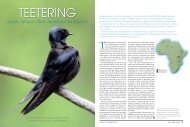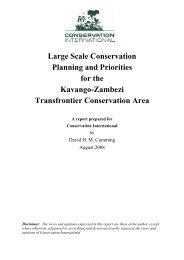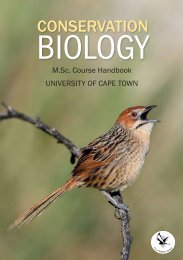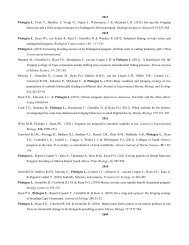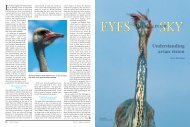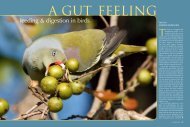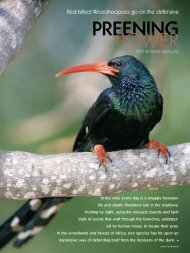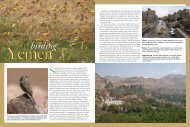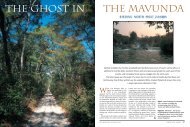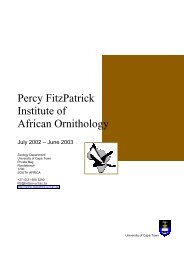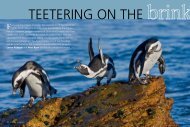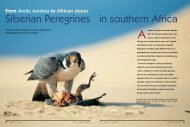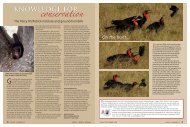Why Penguins no longer follow Ostriches: the new
Why Penguins no longer follow Ostriches: the new
Why Penguins no longer follow Ostriches: the new
Create successful ePaper yourself
Turn your PDF publications into a flip-book with our unique Google optimized e-Paper software.
TONY CAMACHO<br />
66 africa – birds & birding<br />
ThE PAST FEw dECAdES have seen a revolution in bird systematics – <strong>the</strong> study of bird<br />
relationships. Molecular techniques assessing genetic differences between species have<br />
forced some radical changes in <strong>the</strong> way we think birds evolved – and hence <strong>the</strong> way we<br />
classify <strong>the</strong>m. This process is ongoing, but sufficient consensus has emerged for several<br />
field guides and bird books to take <strong>the</strong> plunge and adopt <strong>the</strong> <strong>new</strong> order. Peter Ryan<br />
explains some of <strong>the</strong> major changes.<br />
Biologists attempt to classify birds<br />
and o<strong>the</strong>r organisms in a hierarchy<br />
that reflects <strong>the</strong>ir evolutionary<br />
relationships. This is termed natural<br />
classification, and implies that species in<br />
<strong>the</strong> same genus are more closely related<br />
to each o<strong>the</strong>r than those in o<strong>the</strong>r genera,<br />
and that families in <strong>the</strong> same order<br />
are more closely related to each o<strong>the</strong>r<br />
than to o<strong>the</strong>r families, etc. There are<br />
o<strong>the</strong>r ways to group birds – by colour,<br />
size or even alphabetically – but <strong>the</strong>se<br />
are artificial classifications which, albeit<br />
useful for some purposes, are imposed<br />
ra<strong>the</strong>r than inherent. The advantage of<br />
using a natural classification system is<br />
that it tells us about <strong>the</strong> fundamental<br />
relationships among birds. The main<br />
disadvantage is that as our k<strong>no</strong>wledge<br />
improves, so <strong>the</strong> classification is likely to<br />
change. Such changes have even taken<br />
place at <strong>the</strong> highest levels of classification.<br />
Whereas <strong>the</strong>re used to be two kingdoms<br />
of organisms, animals and plants,<br />
we <strong>no</strong>w recognise six kingdoms, divided<br />
into two domains.<br />
Orders and families take <strong>the</strong>ir names<br />
from one of <strong>the</strong>ir typical genera, but<br />
are distinguished by specific suffixes:<br />
iformes for orders and idae for families.<br />
O<strong>the</strong>r levels in <strong>the</strong> hierarchy may be<br />
recognised, such as Superfamily (oidea),<br />
Subfamily (inae) and Tribe (ini, between<br />
subfamily and genus). Sometimes <strong>the</strong><br />
level at which a group is pegged is<br />
debatable. For example, <strong>the</strong> avocets and<br />
stilts are often treated as a subfamily<br />
Recurvirostrinae of a more in clusive<br />
Charadriidae, <strong>the</strong> plovers and lapwings.<br />
The unique structural adaptations for<br />
life as a flightless, wing-propelled diver<br />
resulted in penguins being placed at <strong>the</strong><br />
start of <strong>the</strong> sequence of modern birds,<br />
but <strong>the</strong>y don’t reflect <strong>the</strong> penguins’<br />
true relationships.<br />
Evolutionary relationships can be<br />
inferred from <strong>the</strong> pattern of shared<br />
derived characters – features common to<br />
a group that are <strong>no</strong>t shared with more<br />
distantlyrelated species. The trick is to<br />
identify which sets of characters convey<br />
a meaningful evolutionary signal.<br />
Many birds share <strong>the</strong> same characteristics<br />
simply because <strong>the</strong>y live in <strong>the</strong><br />
same environment or feed on <strong>the</strong> same<br />
type of food. This is termed convergent<br />
evolution. Relationships are also confounded<br />
by reversals in character states,<br />
whereby some of a related group of<br />
organisms have reverted to <strong>the</strong> ancestral<br />
condition.<br />
Initial attempts to infer <strong>the</strong> relationships<br />
among birds were based largely on<br />
<strong>the</strong>ir shape and structure, but it soon<br />
became apparent that characters subject<br />
to selection for immediate survival, such<br />
as bill, wing and leg shape, carry little<br />
deep evolutionary signal. Focus <strong>the</strong>n<br />
switched to more conserved characters,<br />
such as bones, muscles and o<strong>the</strong>r internal<br />
structures. These formed <strong>the</strong> basis<br />
for <strong>the</strong> classification of birds into orders<br />
and families, whereas external appearance<br />
and structure were used to group<br />
similar species into genera.<br />
Bird taxo<strong>no</strong>my was hotly debated<br />
during <strong>the</strong> late 19th and early 20th<br />
centuries, but a fairly stable order was<br />
established by <strong>the</strong> 1950s, reflecting at<br />
best a consensus based on <strong>the</strong> available<br />
evidence, or at worst a compromise<br />
between opposing factions. This resulted<br />
in <strong>the</strong> familiar sequence in which birds<br />
were listed in bird books.<br />
The past few decades have seen a<br />
revolution in taxo<strong>no</strong>my thanks to <strong>the</strong><br />
development of techniques that detect<br />
and analyse differences among organisms<br />
in <strong>the</strong> most fundamental building<br />
blocks of life – <strong>the</strong>ir genes. Because most<br />
genes mutate at random, <strong>the</strong>y provide<br />
power ful tools for inferring evolutionary<br />
ClaSSifying birdS<br />
Every species is placed in a hierarchical<br />
structure that should reflect its evolutionary<br />
history. For example, <strong>the</strong> Black-winged Stilt<br />
is classified as <strong>follow</strong>s:<br />
Domain: Eukarya (as distinct from Prokarya,<br />
<strong>the</strong> bacteria and archaebacteria)<br />
Kingdom: Animalia (as distinct from Plantae,<br />
Fungi and Protista)<br />
Phylum: Chordata (as distinct from all <strong>the</strong><br />
invertebrate phyla)<br />
Class: Aves (all birds, although strictly birds<br />
are a subset of di<strong>no</strong>saurian reptiles)<br />
Order (-iformes): Charadriiformes (waders,<br />
gulls, terns, auks and sandgrouse)<br />
Family (-idae): Recurvirostridae (avocets and<br />
stilts)<br />
Genus: Himantopus (<strong>the</strong> stilts)<br />
Species: himantopus (<strong>the</strong> Black-winged Stilt)<br />
relationships. Different genes evolve at<br />
different rates, providing biologists with<br />
a toolkit <strong>the</strong>y can use to assess <strong>the</strong> relationships<br />
among all levels of life. For <strong>the</strong><br />
most part, <strong>the</strong> <strong>new</strong> genetic evidence has<br />
supported <strong>the</strong> relationships among birds,<br />
at least at <strong>the</strong> level of orders, but <strong>the</strong>re<br />
have been some major changes in <strong>the</strong><br />
relationships among and within orders.<br />
Sibley’S ‘tapeStry’<br />
Charles Sibley devoted much of his<br />
career to using molecular markers to<br />
infer evolutionary relationships. During<br />
<strong>the</strong> 1980s he used a relatively crude<br />
technique called DNADNA hybridisation<br />
to conduct pairwise comparisons<br />
between <strong>the</strong> DNA of birds from virtually<br />
all major groups. Toge<strong>the</strong>r with Jon <br />
bird systematics august/september 2005 bird systematics 67
Ahlquist, he amassed e<strong>no</strong>ugh information<br />
to propose an entirely <strong>new</strong> view on<br />
avian relationships.<br />
Sibley confirmed that <strong>the</strong> most basic<br />
division among birds is between <strong>the</strong><br />
Palaeognathae (‘ancient jaws’) and<br />
Neognathae (‘<strong>new</strong> jaws’), which have<br />
fundamentally different palate structures.<br />
The former group, comprising <strong>the</strong> ratites<br />
(ostriches, emus, cassowaries and kiwis,<br />
as well as <strong>the</strong> extinct moas and Elephant<br />
120 100 80 60 40 20 0<br />
millions of years<br />
Bird) and <strong>the</strong> South American tinamous,<br />
are represented in Africa only by <strong>the</strong><br />
ostriches. The striking similarity of <strong>the</strong><br />
large, flightless ratites in all <strong>the</strong> sou<strong>the</strong>rn<br />
continents suggests that <strong>the</strong>y evolved<br />
on <strong>the</strong> ancient sou<strong>the</strong>rn supercontinent<br />
Gondwanaland, which broke up during<br />
<strong>the</strong> Cretaceous, about 120–85 million<br />
years ago, to form Africa, Australia, South<br />
America, Antarctica, Madagascar and <strong>the</strong><br />
Indian subcontinent.<br />
Struthioniformes (ostriches, rheas, emu, cassowaries<br />
and kiwis)<br />
Tinamiformes (tinamous)<br />
Craciformes (megapodes, curassows and guans)<br />
PALAEO-<br />
GNAThAE<br />
GALLO-<br />
Galliformes (guineafowls, quail, pheasants and francolins)<br />
ANSERAE<br />
Anseriformes (screamers, ducks and geese)<br />
Turniciformes (buttonquail)<br />
Piciformes (honeyguides, woodpeckers, barbets and toucans)<br />
Galbuliformes (jacamars and puffbirds)<br />
Buceratiformes (hornbills)<br />
Upupiformes (hoopoes, woodhoopoes and scimitarbills)<br />
Trogoniformes (trogons)<br />
Coraciiformes (rollers, motmots, todies, kingfishers and<br />
bee-eaters)<br />
Coliiformes (mousebirds)<br />
Cuculiformes (cuckoos, malkohas, coucals, hoatzin, anis and<br />
roadrunners)<br />
Psittaciformes (parrots, parakeets, lovebirds, lories, amazons<br />
and macaws)<br />
Apodiformes (swifts)<br />
Trochiliformes (hummingbirds)<br />
Musophagiformes (turacos)<br />
Strigiformes (owls, nightjars, frogmouths, Oilbird and potoos)<br />
Columbiformes (pigeons and doves)<br />
Gruiformes (bustards, mesites, seriemas, finfoots, rails,<br />
trumpeters, cranes, Limpkin, Sunbittern and Kagu)<br />
Charadriiformes (sandgrouse, thick-knees, sheathbills, plovers,<br />
oystercatchers, avocets, stilts, jacanas, sandpipers, snipes,<br />
coursers, pratincoles, gulls, terns, skimmers, skuas and auks)<br />
Falconiformes (Osprey, kites, fish eagles, vultures, hawks,<br />
accipiters, eagles, Secretarybird and falcons)<br />
Ciconiiformes (grebes, tropicbirds, gannets, cormorants, herons,<br />
hamerkop, flamingos, ibises, pelicans, New world vultures,<br />
storks, frigatebirds, penguins, divers, petrels and albatrosses)<br />
Passeriformes (perching birds)<br />
relationships among bird orders, showing <strong>the</strong> approximate time that lineages diverged.<br />
Many of <strong>the</strong> relationships among neoaves orders remain unresolved.<br />
Until recently, it was assumed that <strong>the</strong><br />
breakup of Gondwanaland took place<br />
too long ago to have influenced <strong>the</strong> radiation<br />
of <strong>the</strong> more modern neognaths,<br />
despite intriguing similarities between<br />
some widely scattered birds. For example,<br />
<strong>the</strong> flightless Kagu of New Caledonia<br />
is surprisingly similar to <strong>the</strong> Sunbittern<br />
from Central and South America. The<br />
problem was that fossils, mainly from<br />
<strong>the</strong> <strong>no</strong>r<strong>the</strong>rn hemisphere, suggest that<br />
modern birds only appeared approximately<br />
65 million years ago, immediately<br />
after <strong>the</strong> Cretaceous–Tertiary<br />
extinction which saw <strong>the</strong> demise of <strong>the</strong><br />
di<strong>no</strong>saurs. However, differences in gene<br />
sequences suggest that <strong>the</strong> neognath<br />
orders diverged at least 80–90 million<br />
years ago, when <strong>the</strong> sou<strong>the</strong>rn continents<br />
were still close toge<strong>the</strong>r. The appearance<br />
of modern bird fossils in <strong>the</strong> <strong>no</strong>r<strong>the</strong>rn<br />
hemisphere coincides with <strong>the</strong> collision<br />
between <strong>the</strong> Indian plate and Asia some<br />
65 million years ago.<br />
Within <strong>the</strong> neognaths, <strong>the</strong>re are two<br />
major groupings: a basal radiation<br />
of gamebirds and waterfowl, <strong>the</strong> Galloanserae,<br />
with all remaining birds in <strong>the</strong><br />
Neoaves (‘<strong>new</strong> birds’). Among <strong>the</strong> Galloanserae,<br />
only <strong>the</strong> Craciformes (megapodes,<br />
guans and currassows) are <strong>no</strong>t<br />
found in Africa. Both <strong>the</strong> Galliformes<br />
and Anseriformes are well represented<br />
here, including an endemic family,<br />
<strong>the</strong> guineafowls, Numididae. Previously,<br />
penguins were placed at <strong>the</strong> start of <strong>the</strong><br />
neognaths, but <strong>the</strong>ir peculiar morphology<br />
is merely an extreme adaptation to<br />
<strong>the</strong>ir diving lifestyle. In fact, <strong>the</strong>y are<br />
quite closely related to albatrosses and<br />
petrels, and more distantly to a suite of<br />
o<strong>the</strong>r waterbirds, including grebes, herons,<br />
storks and cormorants.<br />
The sequence of orders within <strong>the</strong><br />
Neoaves remains poorly resolved, possibly<br />
because <strong>the</strong>ir initial radiation was<br />
quite rapid. DNADNA hybridisation suggests<br />
that buttonquails are <strong>the</strong> basal<br />
group, <strong>follow</strong>ed by woodpeckers, barbets<br />
and a slew of o<strong>the</strong>r ‘nearpasserine’<br />
orders. Of <strong>the</strong> orders in Neoaves, only <strong>the</strong><br />
Galbuliformes (jacamars and puffbirds)<br />
and Trochiliformes (hummingbirds) are<br />
<strong>no</strong>t represented in Africa, with one order,<br />
<strong>the</strong> Musophagiformes (turacos), being<br />
confined to <strong>the</strong> continent. Despite <strong>the</strong>ir<br />
diverse morphology, most waterbirds,<br />
68 africa – birds & birding<br />
NEOAvES<br />
shorebirds and diurnal raptors are more<br />
closely related than previously thought,<br />
leading to <strong>the</strong> lumping of several orders<br />
of birds. Indeed, Sibley and Ahlquist<br />
advocate lumping <strong>the</strong>m all into a single<br />
enlarged order, Ciconiiformes.<br />
Some orders proved <strong>no</strong>t to be natural<br />
groups. Among <strong>the</strong> former Pelecaniformes,<br />
characterised by four webbed<br />
toes, cormorants, darters, gannets and<br />
boobies are closely related, but pelicans,<br />
tropicbirds and frigatebirds are <strong>no</strong>t.<br />
Similar errors were detected at o<strong>the</strong>r<br />
taxo<strong>no</strong>mic levels. Families such as <strong>the</strong><br />
cuckoos and barbets were split because<br />
<strong>the</strong>y are <strong>no</strong>t natural groups, and <strong>new</strong><br />
light was shed on <strong>the</strong> longdebated<br />
positions of several enigmatic taxa. For<br />
example, <strong>the</strong> Shoebill Balaeniceps rex is<br />
a derived pelican, and <strong>the</strong> New World<br />
vultures and condors are related to<br />
storks, and are merely convergent with<br />
Old World vultures.<br />
Perhaps <strong>the</strong> most exciting result was<br />
<strong>the</strong> development of a framework for <strong>the</strong><br />
largest avian order, <strong>the</strong> Passeriformes.<br />
With more than 5 700 species, passerines<br />
make up some 60 per cent of<br />
<strong>the</strong> world’s birds. Traditionally, differences<br />
in syrinx musculature and o<strong>the</strong>r<br />
structural differences have been used to<br />
divide <strong>the</strong>m into two groups: <strong>the</strong> suboscines<br />
(pittas, broadbills, asities and a<br />
host of Neotropical groups including<br />
woodcreepers, antbirds, tapaculos, cotingas,<br />
manakins and tyrantflycatchers)<br />
and <strong>the</strong> oscines. Among <strong>the</strong> oscines or<br />
songbirds <strong>the</strong>re has been <strong>no</strong> convincing<br />
structure, with convergence clearly confounding<br />
relationships among groups<br />
such as warblers and flycatchers.<br />
Sibley and Ahlquist found that a<br />
diverse array of enigmatic passerines<br />
from Australasia are <strong>no</strong>t <strong>the</strong> last gasp of<br />
boreal radiations, but ra<strong>the</strong>r are basal<br />
forms of <strong>the</strong> original radiation of oscine<br />
passerines. They recognised two major<br />
groups, one of which, <strong>the</strong> Corvida,<br />
comprises AustraloPapuan endemics,<br />
plus several more widespread lineages.<br />
Families found in Africa include crows,<br />
shrikes, drongos, crestedflycatchers,<br />
orioles and cuckooshrikes, with bushshrikes,<br />
batises and wattleeyes endemic<br />
to <strong>the</strong> continent. All remaining species<br />
(some 35 per cent of all birds) were<br />
placed in <strong>the</strong> Passerida, with three super<br />
Rheas, such as this Greater Rhea, bear a striking<br />
resemblance to ostriches, even though South America<br />
broke away from Africa some 110 million years ago.<br />
families: <strong>the</strong> Muscicapoidea (thrushes,<br />
fly catchers, starlings and allies), <strong>the</strong><br />
Sylvioidea (tits, larks, warblers, babblers,<br />
bulbuls, whiteeyes and allies) and <strong>the</strong><br />
Passeroidea (sunbirds, weavers, sparrows,<br />
pipits, canaries, buntings and allies).<br />
a tree of life for birdS<br />
Subsequent work using conserved<br />
nuclear gene sequences has refined<br />
some of Sibley and Ahlquist’s original<br />
conclusions, and a coherent picture<br />
of how <strong>the</strong> passerines evolved is<br />
slowly emerging. The New Zealand<br />
wrens (Acanthisittidae) are basal to all<br />
o<strong>the</strong>r passerines, again emphasising <strong>the</strong><br />
importance of <strong>the</strong> sou<strong>the</strong>rn hemisphere<br />
in avian evolution (at least as a refuge<br />
for relictual species). The fundamental<br />
split into suboscines and oscines is supported,<br />
but all <strong>the</strong> oscines appear to<br />
have arisen from <strong>the</strong> Australasian radiation,<br />
with <strong>the</strong> Passerida nested within<br />
<strong>the</strong> Corvida. And within this radiation,<br />
some enigmatic African species have<br />
assumed prominent positions. The rockjumpers<br />
of sou<strong>the</strong>rn African and <strong>the</strong><br />
picathartes of West and Central Africa<br />
are sister groups, basal to all o<strong>the</strong>r passeridan<br />
birds. This suggests that Africa<br />
played an important role in <strong>the</strong> early<br />
radiation of <strong>the</strong> Passerida.<br />
There is still lots to learn about <strong>the</strong><br />
Passerida. Sibley’s view of three major<br />
groups has been challenged, with several<br />
families falling outside <strong>the</strong> neat tripartite<br />
structure. From an African perspective,<br />
several unexpected relationships have<br />
emerged. The elminias, a group of small,<br />
fantailed ‘flycatchers’, are merely convergent<br />
with <strong>the</strong> crestedflycatchers and<br />
paradiseflycatchers of <strong>the</strong> Corvoidea,<br />
and fall within <strong>the</strong> Passerida. Toge<strong>the</strong>r<br />
with <strong>the</strong> Asian Culicicapa flycatchers<br />
and <strong>the</strong> Fairy Flycatcher, <strong>the</strong>y form<br />
a separate radiation allied to <strong>the</strong> tits.<br />
Livingstone’s Flycatcher and <strong>the</strong> o<strong>the</strong>r<br />
Erythrocercus flycatchers apparently form<br />
a separate flycatcherlike radiation within<br />
<strong>the</strong> Sylvioidea. The nicators, which have<br />
been bounced back and forth between<br />
<strong>the</strong> bulbuls and bushshrikes, belong<br />
to nei<strong>the</strong>r group, apparently forming a<br />
basal lineage within <strong>the</strong> Sylvioidea. And<br />
one of <strong>the</strong> most bizarre results is that <strong>the</strong><br />
sugarbirds, endemic to sou<strong>the</strong>rn Africa,<br />
appear to be basal to <strong>the</strong> Passeroidea,<br />
toge<strong>the</strong>r with Spotthroat and Dapplethroat,<br />
enigmatic forest understorey<br />
‘babblers’ confined to <strong>the</strong> Eastern Arc<br />
mountains of East–Central Africa.<br />
One of <strong>the</strong> least well understood<br />
groups has been <strong>the</strong> Old World warblerbabbler<br />
complex. The warblers were<br />
traditionally placed in a single family,<br />
Sylviidae. Sibley recognised <strong>the</strong><br />
distinctiveness of <strong>the</strong> largely African<br />
Cisticolidae (prinias, cisticolas, apalises,<br />
camaropteras, tailorbirds, etc), but failed<br />
to appreciate <strong>the</strong> full extent of <strong>the</strong><br />
problem within <strong>the</strong> remaining warblers.<br />
The predominantly Palearctic Sylvia <br />
bird systematics august/september 2005 bird systematics 69<br />
peTer ryan
warblers are more closely related to bab <br />
blers, whiteeyes and laughingthrushes<br />
than to o<strong>the</strong>r warblers. Preliminary<br />
evidence suggests that <strong>the</strong> remaining<br />
warblers also are deeply divided and<br />
probably should be split into several<br />
<strong>new</strong> families, including a<strong>no</strong><strong>the</strong>r largely<br />
African group that would embrace<br />
<strong>the</strong> crombecs, eremomelas, longbills,<br />
Grassbird, Rockrunner and Victorin’s<br />
Warbler. True Bradypterus warblers form<br />
part of a diverse array of African, Asian<br />
and Australasian warblers that groups<br />
with <strong>the</strong> Madagascan radiation of ‘babblers’<br />
and ‘bulbuls’.<br />
Much work remains to be done, but <strong>the</strong><br />
rate of progress is astounding. Molecular<br />
techniques have improved to <strong>the</strong> point<br />
where what once seemed impossible,<br />
such as sequencing <strong>the</strong> entire human<br />
ge<strong>no</strong>me, is merely tedious. Earlier this<br />
year <strong>the</strong> entire ge<strong>no</strong>me for <strong>the</strong> chicken<br />
was published with surprisingly little<br />
fanfare. Within systematics, <strong>the</strong>re is a<br />
concerted push to discover <strong>the</strong> ‘tree of<br />
life’, <strong>the</strong> history of <strong>the</strong> evolution of all<br />
life on earth. This requires sequencing<br />
a suite of conserved genes from literally<br />
thousands of organisms, including hundreds<br />
of birds. Such initiatives will result<br />
in a stable familylevel structure within<br />
<strong>the</strong> next few years, but <strong>new</strong> surprises<br />
will doubtless emerge as more and more<br />
genera are sequenced.<br />
Some birders may consider <strong>the</strong>se discoveries<br />
irrelevant, and grumble about<br />
changes to <strong>the</strong> old, familiar bird sequence.<br />
But you can<strong>no</strong>t understand an organism<br />
and how it fits into its environment<br />
without also k<strong>no</strong>wing its evolutionary<br />
history, and <strong>the</strong> constraints imposed by<br />
that history. K<strong>no</strong>wing <strong>the</strong> relationships<br />
among <strong>the</strong> birds we watch can only<br />
enhance our birding experience. <br />
New Zealand wrens (Acanthisittidae)<br />
Old world suboscines: pittas, broadbills, asities<br />
New world suboscines: ovenbirds, spinetails, ant-birds, woodcreepers, gnateaters, tapaculos, cotingas, manakins,<br />
tyrant-flycatchers and allies<br />
Menuroidea: lyrebirds and scrub-birds<br />
Ancient Australasian endemics: bowerbirds, whipbirds, honeyeaters, quail-thrushes, scrub-wrens and allies, including<br />
Australian ‘babblers’, ‘wrens’, ‘warblers’ etc.<br />
Corvoidea (core families): crows, true shrikes, vireos, drongos, fantails, birds-of-paradise, crested-flycatchers,<br />
paradise-flycatchers, Old world orioles, ioras, vangas, bush-shrikes, batises, wattle-eyes, cuckooshrikes, wood swallows<br />
and sundry Australasian endemics<br />
Picathartidae: rockfowl<br />
Chaetopidae: rock-jumpers<br />
Petroicidae: Australian robins<br />
Muscicapoidea: waxwings, flycatchers, chats, wheatears, thrushes, robins, dippers, starlings, mynas and mockingbirds<br />
Nuthatches, creepers, wrens, gnat-catchers (‘Certhioidea’)<br />
Tits, penduline tits, elminias and Fairy Flycatcher<br />
Sylvioidea: larks, nicators, Old world warblers, long-tailed tits, swallows, Erythrocercus ‘flycatchers’, bulbuls, babblers,<br />
laughing-thrushes, white-eyes<br />
Passeroidea: sugarbirds, leafbirds, sunbirds, flowerpeckers, weavers, widowbirds, finches, whydahs, sparrows, wagtails,<br />
pipits, accentors, canaries, honeycreepers, buntings, tanagers, and New world ‘warblers’, ‘orioles’ and ‘blackbirds’<br />
relationships within <strong>the</strong> passeriformes, <strong>the</strong> largest order of birds.<br />
70 bird systematics<br />
africa – birds & birding<br />
peTer ryan<br />
The taxo<strong>no</strong>my of <strong>the</strong> Old<br />
World Warblers, such as this<br />
Lesser Swamp Warbler, remain<br />
in a state of flux. It is likely<br />
that <strong>the</strong>y will be split into<br />
several <strong>new</strong> families.



